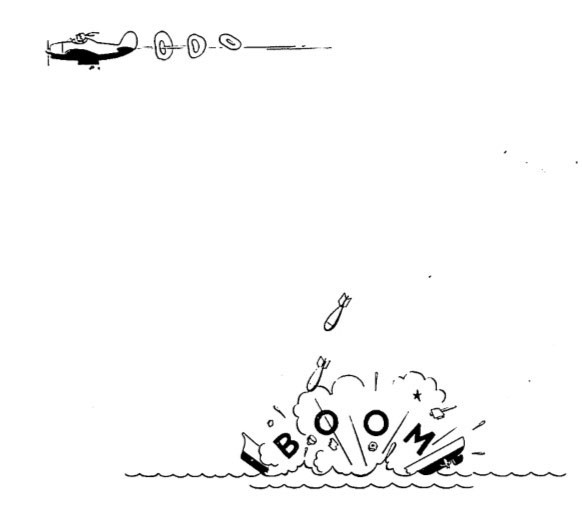
The Navy Department Library
SHIP SHAPES
ANATOMY AND TYPES OF NAVAL VESSELS
PDF Version [3.6MB]
DECLASSIFIED
O.N.I. 223 SHIP SHAPES
NAVY DEPARTMENT
OFFICE OF THE CHIEF OF NAVAL OPERATIONS--
WASHINGTON, D.C.
DECEMBER 9, 1942
1. 0. N. I .223 has been prepared in answer to a growing demand for a more generalized treatment of the subject of warship identification.
2. Since the outbreak of war the Division of Naval Intelligence has issued a considerable number of publications dealing with the appearance of our own naval vessels, with those of allied and neutral nations and the fleets of our opponents. Written and illustrated by the officers and civilian personnel who have prepared material for 0. N. I. Standard Navy Manuals, O. N. I. 223 represents an effort to simplify ship recognition for personnel in training and for the fighting forces.
3. The first section of this publication may be regarded as a primer for thosewhose knowledge of the elements that constitute a fighting fleet is limited. This section describes briefly the functions of the more important combatant types and auxiliaries and their characteristics. It also contains a glossary of common marine terminology and illustrates the salient elements of war- ship design, with their names and common variations.
4. Additional sections of 0. N. I.223 will he published as material is com-pleted, and will deal with the national characteristics of the major navies, with the distinctive characteristics of individual fleets and with methods and techniques of ship identification.
H.C. TRAIN,
Rear Admiral, U.S. Navy
Director of Naval Intelligence
DECLASSIFIED
Serial No. 4391716 - Op-16-F-20 - S1/EF/EG-A6-3/FS
1
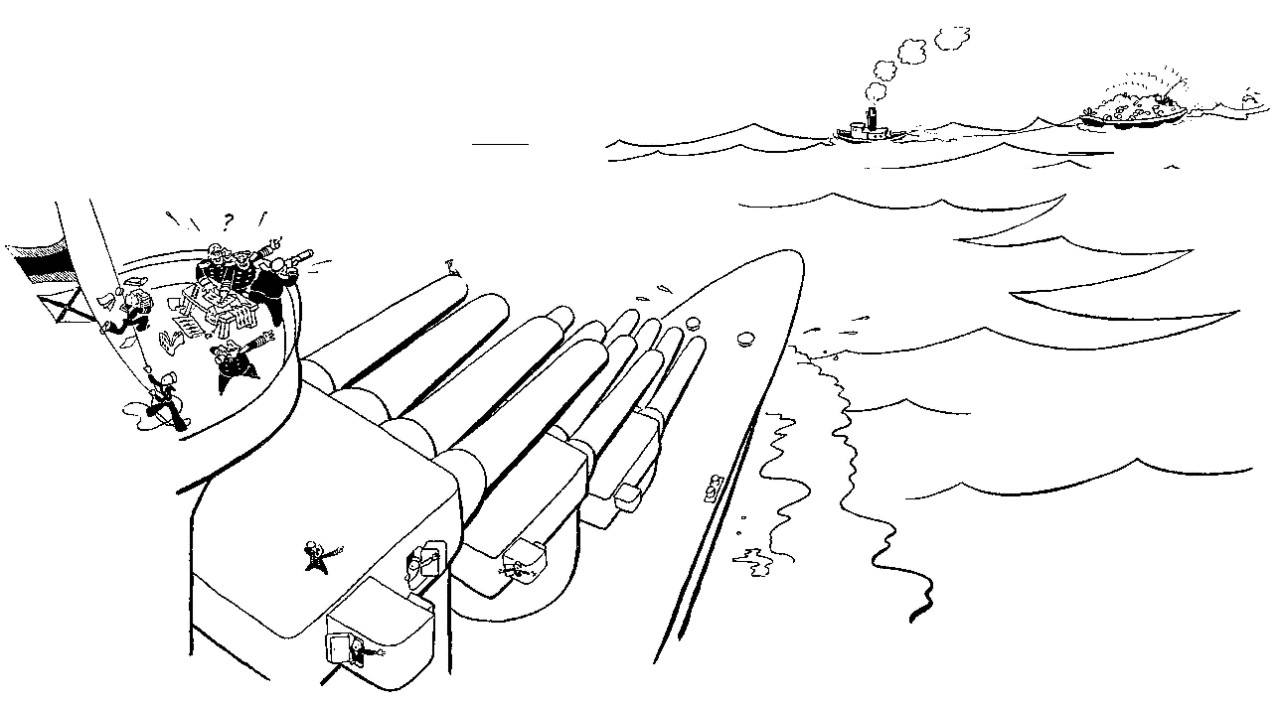
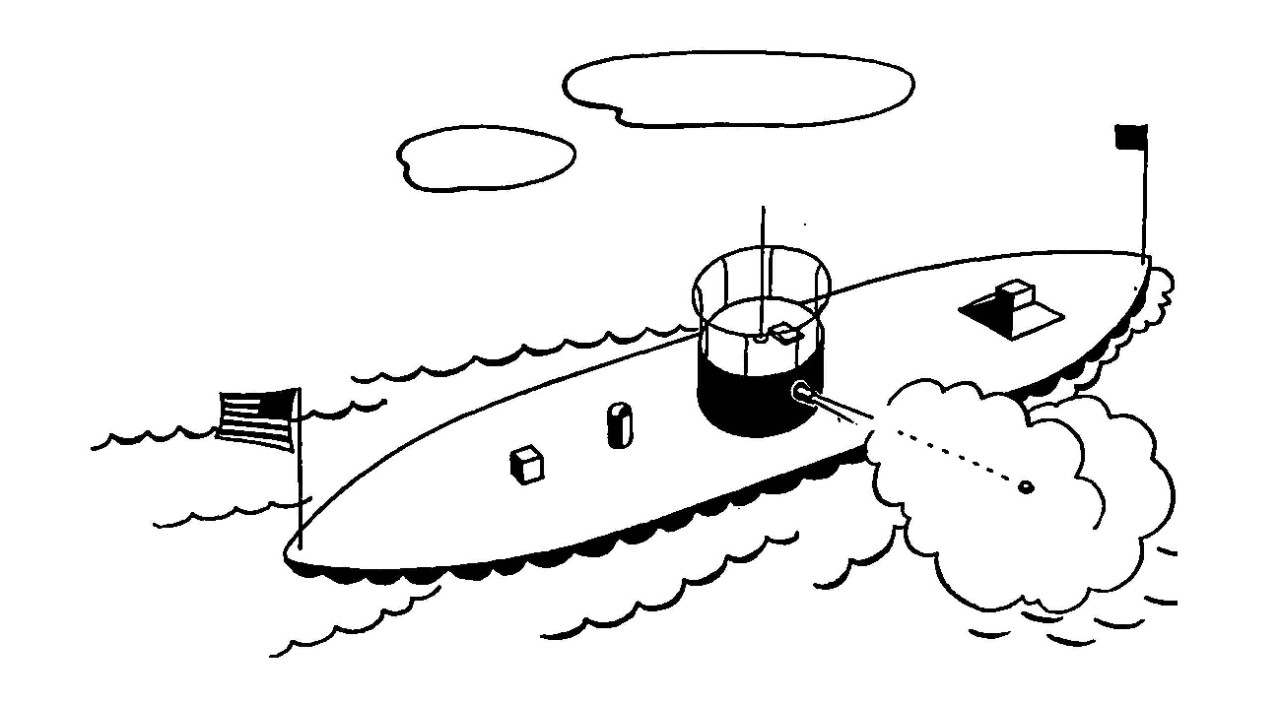
Combatants in the present war have consistantly bombed and shot at their own ships and those of their allies. A large body of opinion maintains that the Italians, for instance, would he obliging enough to eliminate their fleet from the Mediterranean if left to their own devices.
While the objective of all seagoing personnel should be to recognize important ships or types at a glance, familiarity with the details of naval design illustrated in the following pages may prove of value to the student of ship identification. Determination of a ship's type must constitute a primary step in identification in combat areas. Since accurate estimation of a ship's size is extremely difficult at sea, an observer may have occasion to resort to certain rules of thumb to differentiate various types of fighting ships. A discussion of the factors that may be employed to distinguish these types, and of the common variants that occur within the types themselves, will be found in this section of 0. N. I. 223.
Of all fighting ships, the old Monitor must have been about the easiest to identify. She had a single turret and a single stack on a wide flat hull, and that was all that could be said about her. Modern warships have become a good deal more complex. In fact there are no two warships in the world that look precisely alike. An expert can tell even sister ships apart by minor
differences in their masts or superstructures. All ships share in some degree the essential characteristics of their type, and as one becomes familiar with ships one also becomes increasingly aware of the peculiar national character that distinguishes ships of the world's navies.
"Spot" identification of ships at sea is not always possible or desirable. The appearance of individual warships is constantly undergoing alteration in time of war and consideration must be given, for purposes of identification, to ele ments of structure that are least subject to change, such as main armament and hull proportions. "Progressive" identification, or identification through observation of detail, will often constitute the basis for a more dependable check on a ship's identity than the general impression of an observer. For this reason, variations in structural elements that appear in all fighting ships are illustrated in this section, aswell as those which serve to differentiate types, with terms commonly applied to them. The progressive method is considered especially well suited to descriptive reporting of ships' appearance. A method of reporting such data appears in 0. N. I. 223-K, Warships in Code, recently published by the Division of Naval Intelligence.
3
NOTE: Terms later defined in the text of this section have been omitted in the following list.
| ABAFT--behind; toward stern from. | BOOM--a free swinging spar used to secure boats or handle cargo, boats or aircraft. | CLASS--vessels of the same type built to a common basic design |
| ABEAM--at right angles to the keel. | BREAK--the point at which upper decks are discontinued. | COMBINED OPERATIONS--joint operations conducted by nonhomogeneous forces or forces of different services and/or nationalities. |
| AMIDSHIPS--the middle portion of a vessel. | BRIDGE--raised forward platform from which ship is conned and navigated. | COMPANIONWAY--hatchway providing access from one deck to another. |
| ARMOR--steel plating designed to defeat shells, bombs, or underwater explosion. | BULKHEAD--transverse or longitudinal partitions subdividing the interior of a ship. | COMPARTMENTATION--subdivision of a ship's hull by means of transverse and/or longitudinal bulkheads. |
| ARMOR BELT--band of armor extending along a ship's sides above and below water-line. | BULWARKS--light plating or wooden extension of ship's sides above upper deck. | CONNING TOWER--armored ship control station. In submarines, the main deck structure. |
| ARMOR BELT--band of armor extending along a ship's sides above and below water-line. | CASEMATE--armored gun mount built inot the sides or superstructure of a ship. | |
| BEAM--extreme width of ship. | ||
| BILGE--curved part of ship's hull where sides and flat bottom meet. | ||
| BLISTER--a bulge built into a ship's side as a protecton against torpedoes. |
4
TERMINOLOGY
| COUNTER--side of a vessel's quarter. | HULL--main body of a vessel exclusive of elements of superstructure. | RECIPROCATING ENGINE--a steam actuated piston engine as distinguished from turbine. |
| COWL--a smoke baffle located on top of a funnel; opening of a ventilator. | ISLAND--a free-standing section of a ship's superstructure. On aircraft carriers, the ship's superstructure. | RIGGING--collective term for ropes and chains employed to support masts, yards, and booms of vessel. |
| DAMAGE CONTROL--comprehensive term for all means of mitigating or offsetting effects of damage aboard ship. | KEEL--center line strength member running fore and aft along the bottom of a ship. | SECONDARY BATTERY--the gun aramament next in calibre to main battery. |
| DEPTH CHARGE--explosive device projected or dropped from air or surface craft; detonated at predetermined depths by a hydrostatic mechanism. | KNOT--a unit of speed, equalling one nautical mile (6,080.20 feet) per hour. | SHEER--longitudinal upward or downward curvature of deck or gunwhale. |
| DISPLACEMENT--the weight of water displaced by a ship | LIST--transverse inclination of a vessel. | SHEER LINE--line formed by intersection of deck and sides of a ship. |
| FANTAIL--after section of the main deck. | MAIN BATTERY--the heaviest calibre gun armament carried by a naval vessel. | SPLINTER SCREEN--light armor shields for protection of crew. |
| FORE--that part of a ship lying between bow and midship section. | MAIN DECK--a ship's highest continuous deck. | STACK--exposed uptake from ship's boilers; funnel. |
| FORE AND AFT--lengthwise or a ship. | MINE--a device containing high explosive charge, free-floating or anchored at fixed depth, or resting on bottom: detonated by contact, or by electrical or magnetic impulse. | STARBOARD--the right hand side of a vessel when looking towards bow. |
| FORECASTLE--deck; a forward upper deck extending to bow. | MULTIPLE MAST--an exposed mast having one or more supporting elements. | STEM--extreme forward line of bow. |
| FREEBOARD--height of a ship's sides from waterline to a weather deck. | PEAK (Fore and Aft)--xompartment at the extreme bow or stem of vessel below decks-usually a tank. | STERN POST--the main vertical post in the stern frame upon which the rudder is hung. |
| FLYING BRIDGE--a light self-supporting structure extending from side of ship's bridge. | PORT--left hand side of a vessel when looking towards bow; an opening. | SUPERSTRUCTURE--any structure built above a ship's hull. |
| GUN HOUSE--a lightly protected, rotating mount for guns of lesser calibre. | QUARTER--that portion of a vessel's side near the stern. | TASK FORCE--a naval force organized to carry out a specific mission. |
| GUN SHIELD--any protection for a gun crews which does not completely enclose mount. | QUARTER DECK--part of upper deck reservced for officers; also the deck near the stem. | TURRET--a rotating mount enclosed by armor for guns of large calibre. |
| GUNWALE--upper edge of a vessel's or boat's side. | RADIO DIRECTION FINDER--device for determining direction of source of radio impulses. | TWIN TURRET--a turret housing two guns. |
| HALYARDS--light lines used in hoisting signals, flags, etc. | RAKE--fore and aft inclination from vertical. | TYPE--all vessels built converted for the same purpose. |
| HATCH--opening in a deck. | RANGEFINDER--optical instrument for determining distance to a target or other object. | WEATHER DECK--any deck exposed to weather. |
| HAWSE PIPES--tubes leading anchor chains from deck down and forward through bow plating. | WELL--a lateral opening in a ship's hull or superstructure. | |
| HELM--the mechanism for operating the ship's rudder. |
5
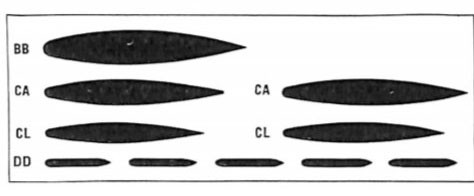
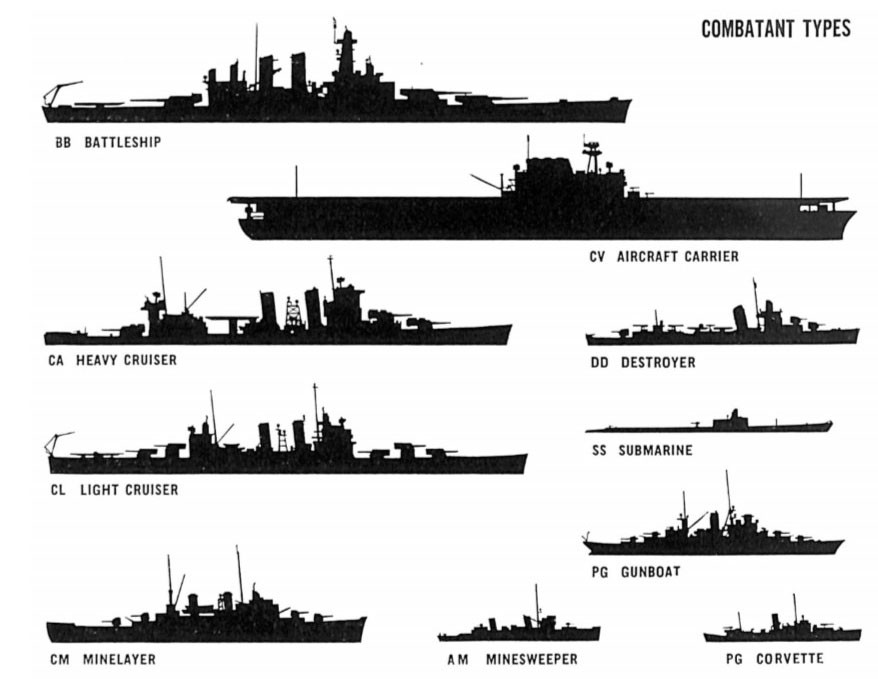
SHIPS OF THE FLEET
The student of ship identification should first of all familiarize himself with the types of ship that make up a modern fleet. On these pages appear the more important types of fighting ship that make up the United States Navy. On this page are shown the major combatant units th at form the Battle Fleet or make up the task forces that have assumed such an important role in the Pacific area. Each of these ships has been designed to play an aggressive role in combat. Each has its place and function in the disposition of the Fleet when at sea. Not all of these ships, however, are intended solely for operation with others. A cruiser or lighter vessel may execute an independent combat mission, preying upon commerce or clearing the sea of raiders and other enemy naval units. Generally speaking, the number of ships of each type in a well-balanced navy will vary inversely with size. Thus, for every battleship, approximately Two heavy cruisers, Two Light cruisers and five destroyers will be built. The relative proportion of our e xisting carriers or of carriers building or contemplated cannot b e expressed in similar terms and is therefore omitted. It will
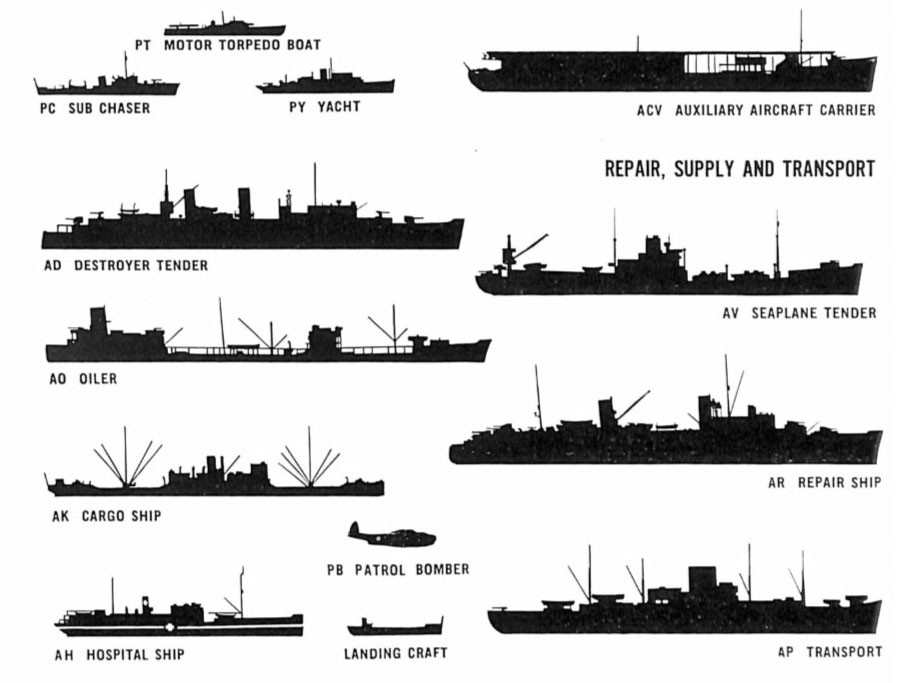
SHIPS OF THE FLEET
suffice to say that the proportion of ships of this type in our Na v y will be greatly increased over the pre-war level. For every ship that is built t o meet an opponent in battle, a dozen are built to perform prosaic but necessary jobs for the maintenance, supply, and protection of t he Fleet and its shore establishments. Many types of repair, supply and transport vessels are constantly engaged in supplying and. maintaining our two-ocean fleet. Extended naval operations would often be impossible without these ships. In waters where adequate docking, repair and fuel facilities do not exist, the crippling of an enemy repair ship or oiler may require modification or abandonment of an important operation. The destruction of an enemy's auxiliaries must , therefore, be regarded as a n objective of major importance.
Identification of such units is important. An observer must be able to distinguish enemy ships of these types from corresponding vessels of his own navy and of his allies'. Accurate reporting of minor enemy ship types present in an operating area is an important factor in anticipating an opponent's plans and in the formation of strategic as well as tactical decisions. It is not enough, therefore, simply to know your own and the enemy's major combatant ships. Fliers especially should become familiar with such minor vessels in order to report accurately the types of the m any ships that will be observed in theaters of war.
7

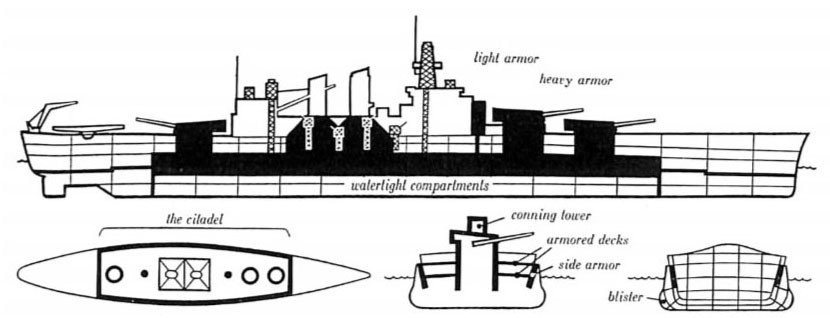
ATTRIBUTES OF FIGHTING SHIPS
A ship, to be classed as a fighting ship, must be capable of inflicting damage and of sustaining or avoiding damage. She must possess sufficient speed and maneuverability to execute her mission and the capacity to proceed independently to a scene of action. The type of a warship is determined by the degree to which each of these qualities has been stressed in her design.
ARMAMENT
Capacity to "dish it out" is a primary attribute of fighting ships. Ships may be designed to inflict damage by shells from their guns, torpedoes from their tubes, bombs from aircraft they may carry, or by depth charges or mines. Battleships and cruisers are essentially gun ships, although they carry other weapons. Carriers, minelayers and torpedo boats are designed for special attack functions, with guns provided largely for defense, while destroyers and submarines are dual armament ships, using either guns or torpedoes. Range finders and AA directors constitute an integral part of the gun armament of warships. Their findings arc sent to plotting rooms, from which ranges are t ransmitted to the guns, which may he fired simultaneously from the main control room or individually from control room or turret. Larger types carry secondary batteries, primarily intended for defense against destroyers or submarines, or, if "dual purpose,” for protection from attack from the air.
PROTECTION
A fighting ship must also be able to "take it." A ship may be designed to absorb punishment, to mitigate its effect, or to avoid it. She may be provided with armor: heavy steel plate around vital parts t o defeat shells, bombs, and torpedoes. Her bull will be subdivided into separate spaces, or provided with bulges or blisters, to confine the effects of flooding and explosion. This is called compartmentation. Damage control systems consisting of provisions for counterflooding, fire fighting, etc., arc developed in varying degrees in all types. Speed and
8


maneuverability in themselves constitute factors of protection in smaller types in which armament and protection have b een sacrificed for these qualities, while submarines depend for protection largely on their ability to make themselves invisible by submerging.
MOBILITY
Most fighting ships are propelled by highpressure steam boilers and geared turbine engines, although Diesel or reciprocating engines are sometimes used in smaller types. Diesels are used in submarines when operating on the surface, electric storage battery motors when submerged.
Since a large proportion of total displacement and space is allotted to armament and protection in the design of battleships, these ships do not attain t he high speeds of most smaller combat units. Carriers are designed for speed, with corresponding sacrifice of armor. Cruisers’ speed will range from 30 knots, which will permit a heavy cruiser to operate with the fleet and outrun most battleships, to speeds of over 40 knots in lighter types. Speed is essential t o a destroyer's functions and new types are capable of attaining or bettering that of any cruiser.
SEAKEEPING
Without the capacity to reach a scene of operations, execute a mission, and return to a base, even the fastest and most powerful fighting ship would be of little value.
To bring an enemy to action is the battleship's primary function, and these ships must carry crews and provisions necessary to take them into battle with enough shells and fuel and food aboard to permit them to fight and return. Since cruisers are often required to perform independent missions at great distances, sea keeping capacity is a vital consideration in their design. Carriers must also be designed to accommodate provision for extended operations and fuel for their aircraft. Destroyers, as they often operate with battle fleets or in convoy, must also carry provision for such work, subject to limitations of size, while submarines are required to remain in enemy waters for extended periods. It will, therefore, be seen that sea keeping is a very important factor in the design of all more important types of fighting ships.
9
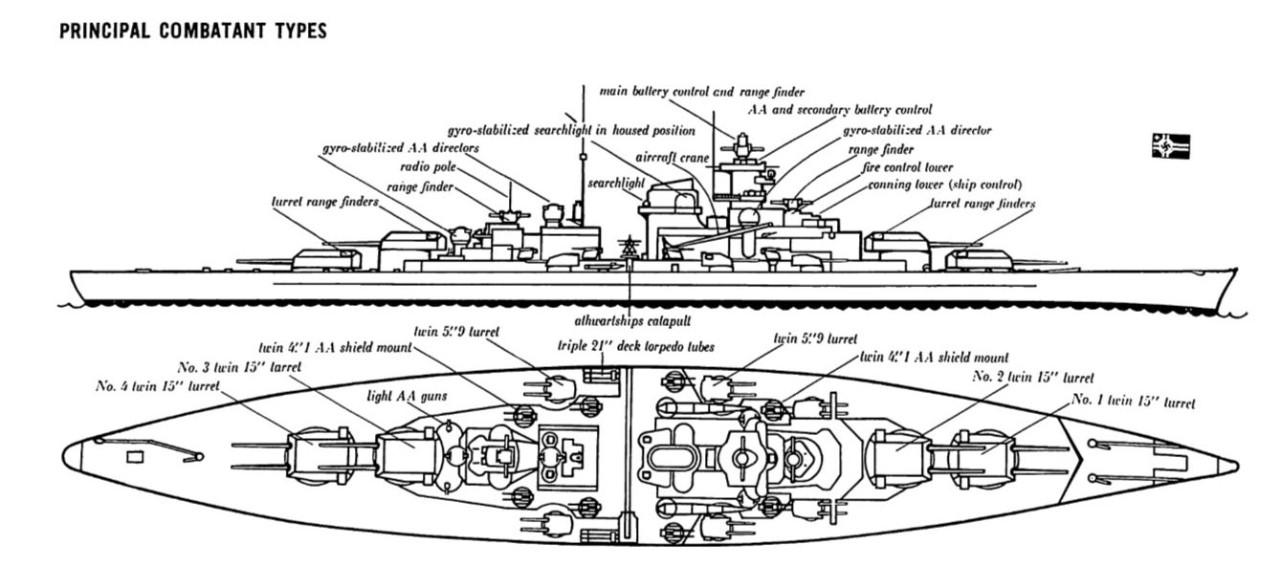
Modern battleships of four major navies are here illustrated. Examination of these ships will disclose peculiarities characteristic of each nation. Hulls, main battery arrangements, stacks, masts, and bridges are as characteristic of national developments in engineering and design as are the types of architecture that are associated with various countries and nationalities.
BB TIRPITZ • T 35,000 • L 817' • B 118' • K 30 • A 8-15'. 12-5.9, 16-41AA.
Tirpitz is the latest example of German capital ship design. Unusual beam makes for great stability and permits extensive compartmentation. Speed, underwater protection, and endurance take precedence over gun power and armor. She is a ship better designed for ocean raiding than for fleet action.
10
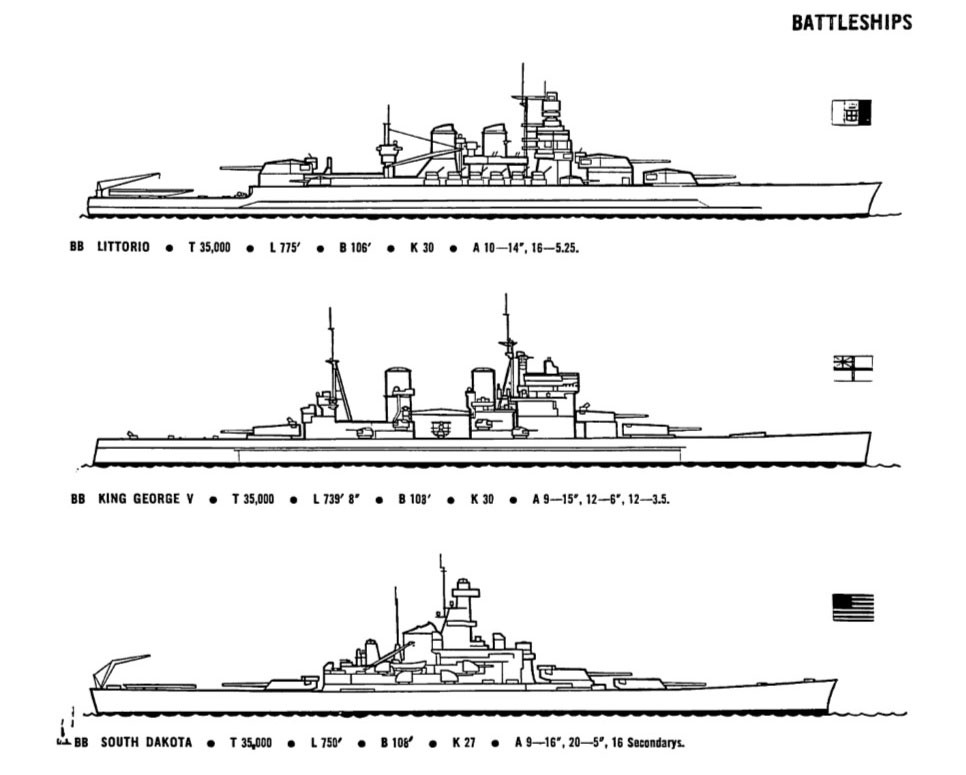
As the largest and most powerful of fighting ships, battleships combine gun power and protection in the highest degree. The speed of modern battleships now approaches that of most fast surface types, and with a few exceptions, their endurance is very great. These ships constitute the Line of Battle. They are mobile fortresses whose principal duty is to meet an enemy's heavy ships and to destroy them; while in combined operations and warfare on commerce they may act as heavy support for other types.
USS SOUTH DAKOTA First and last a heavy lighter, designed to give and receive the heaviest blows. High mobility and endurance fit her for extended operation. This ship marks a new era in the design of U. S. capital ships and embodies the spirit of the offensive.
HMS KING GEORGE V A good all-round lighter, British from keel to truck. Her design reflects a conservative balance of tactical characteristics and a British preference for the construction of large numbers of strategically rugged ships rather than seeking the ultimate in a few record breakers.
HIMS LITTORIO Endowed with an imposing main battery and high speed at the expense of protection, this ship is intended for hit-and-run tactics against all but the weakest opposition. She reflects the political background of the last decade and was built by the Italians to impress rather than to slug it out in combat.
11
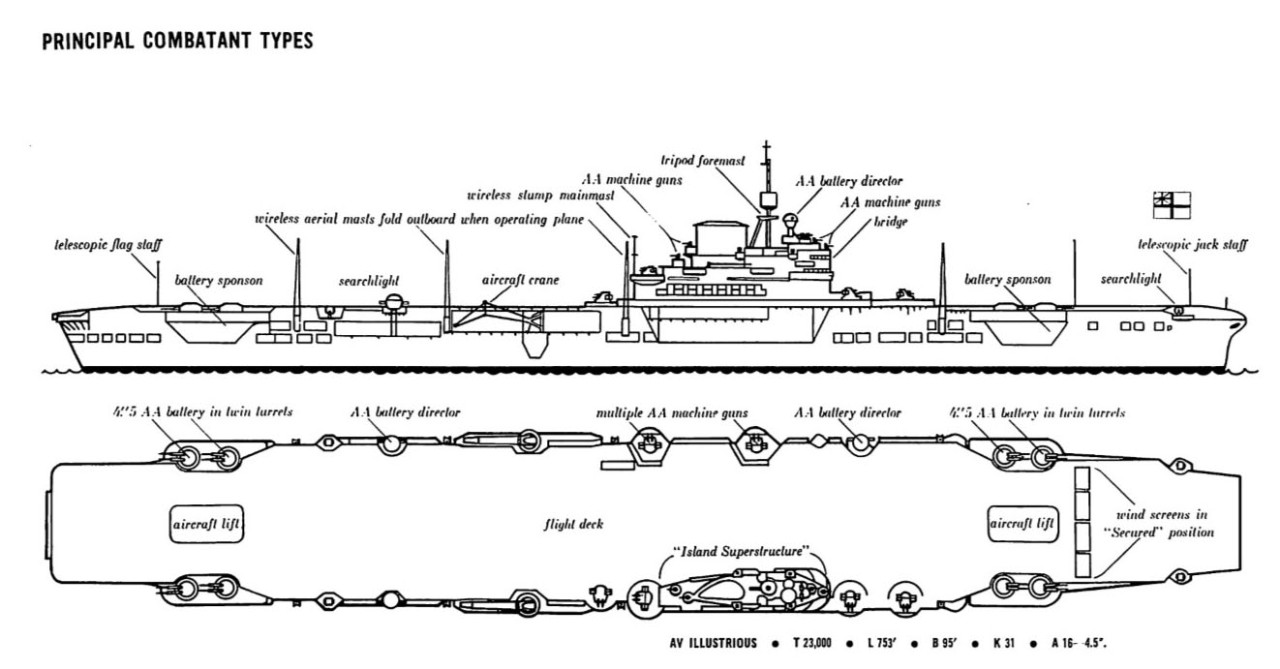
Typical aircraft carriers of various nalionali1ies appear on this and the opposite page. Due to the superficial similarity of ships of this type, for purposes of recognition attention must he concentrated on general proportions and minor variations in slacks, and in bridge and island structures. National characteristics frequently do not constitute a reliable basis for identification in ships of this type.
The Illustrious is a typical modern first-line carrier. She carries about 60 aircraft with adequate provision for their operation and possesses considerable speed and endurance. Her AA battery is a formidable one and she is exceptionally well protected for her 1ypc.
12
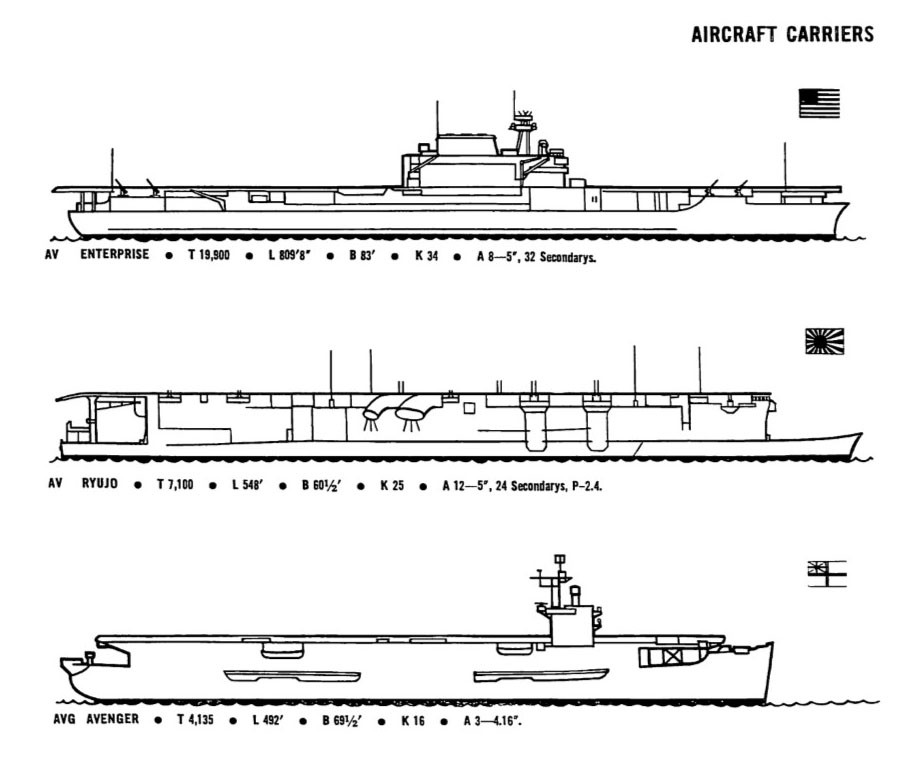
The aircraft carrier is essentially a mobile air base. Her aircraft constitute her offensive arma- ment and the guns she carries are largely for purposes of defense. Torpedo bombers, fighters, and scouting planes are carried for attack, reconnaissance and for defense as well. A carrier's basic design renders her vulnerable to all forms of attack. High speed and great endurance are essential to operation as a long-range surprise attack weapon. Her major purpose is to provide air strength a t sea where shore based aircraft are unavailable.
USS ENTERPRISE Similar to the Illustrious as an example of a first-line carrier. She carries a larger complement of planes, but does not possess defensive armament and protection to the same degree.
HUMS RYUJO Typical of the appearance of recent Japanese carriers, this ship is an experi- ment in development of a smaller type. This is a reflection of reluctance on the part of some naval powers to put "all their eggs in one basket" and of a desire to risk only a relatively small number of planes in a single vessel.
HMS BATTLER An auxiliary aircraft carrier. These ships represent wartime expedients. Their value lies in numbers and expendability. With limited capacity for aircraft, slow and lack- ing protection, their usefulness is restricted to replacing carriers in convoy escort and com· bined operations and functioning as plane ferries.
13


Since cruisers are built to perform a number of duties, they show many variations in size, speed and armament and hence in appearance. Cruiser displacements range from 13,000 to 2,900 tons. A heavy cruiser's guns (usually 8") will outrange any except those of a battleship. These ships may, therefore, serve as line of battle ships in the absence of battleships, in support of carriers in task forces, as independent commerce raiders, as con- voy protectors, or as part of the screen that is thrown out around a fleet in motion. Light cruisers range from vessels of the size of heavy cruisers, carrying lighter armament (usually 6" guns), to extremely fast smaller types whose purpose is primarily that of escort and antiaircraft ships.
Because the dividing line between the "light-light" cruiser and the heavy destroyer or "destroyer-escort" is difficult to define, cruisers and destroyers are treated as a group in the following pages. Comparison of Atago (above) with ships of the Regolo class will show that these ships have little in common, other than the fact that both are grouped under the loose general classification of "cruisers". Consideration must he given as to whether a ship approximates in size, speed and aramment one of the types shown in the following pages, since simple identification of an enemy ship as a cruiser will not greatly contribute to a conclusion as to what to do about it.
The Atago is a heavy cruiser of great mobility and endurance and possess- ing heavy armament and protection. A formidable opponent, she is the "opposite number" of new U. S. heavies of the Wichita class. The lines of her hull, her stacks and her concentrated superstructure are characteristically· Japanese.
Like the new U. S. heavies, she packs a considerable punch, with five twin 8-inch turrets. She exemplifies a tendency present in the design of many large modern warships in the extreme concentration of the elements of her super-structure. The long run of her sheer line towards the bow makes for good sea qualities and leaves room for three turrets forward. Unlike cor- responding ships of our Navy she carries four sets of torpedo tubes, while her catapults, instead of being located on the fan-tail as in our ships, are placed on sponsons on either side aft near a central hangar.
14


The destroyer's name originates from the function for which these ships were originally designed. When the torpedo became an important factor in naval warfare, fast steam-torpedo boats were developed. A larger but similar type carrying heavier gun armament was designed to destroy these ships and the torpedo boat destroyer thus came into existence. The destroyer has now assumed many of the torpedo boat's functions as a "hit and run" ship. Tor- pedoes remain her primary weapon in most instances and sudden attack on enemy ships with rapid withdrawal remains, with screening duties, among the destroyer's chief attributes in fleet combat. Equipped with depth charges they have also become an answer to enemy submarine attack and are widely used in convoy protection. In recent years British, French, Italian, and Japanese destroyers of unusual size have been built and equipped with guns at the expense of their torpedo armament, thus the full cycle has been reached and the "destroyer-destroyer" has appeared. Large destroyers of this sort perform so many of the tasks of light cruisers that a clear line of demarcation between the types is difficult to draw. Generally speaking, the difference lies largely in the presence of some armor in cruisers and in the destroyer's char- acteristic hull form and silhouette.
The Charles Hughes is typical of new U. S. destroyers. Her size reflects high sea speeds and endurance, fitting her for modern "task force" missons. Dual purpose guns in weatherproof gun houses are a characteristic of these ships. Her silhouette is typical of many destroyer classes of all nationalities, with relatively high stacks and high forecastle breaking down to the main deck at the bridge. Seen from above, the lines of her hull form an interesting contrast with those of the cruisers illustrated on the following page. Note· the narrow hull with relatively straight sides, and rounded stern, as opposed to the more tapered hulls of the cruisers. This hull is characteristic of all destroyers, and, seen from the air, will infallibly differentiate these ships from other types. While consistent in general appearance, destroyers are designed for a number of specialized functions, and may vary considerably in size and armament, as may be seen in the following illustrations.
15
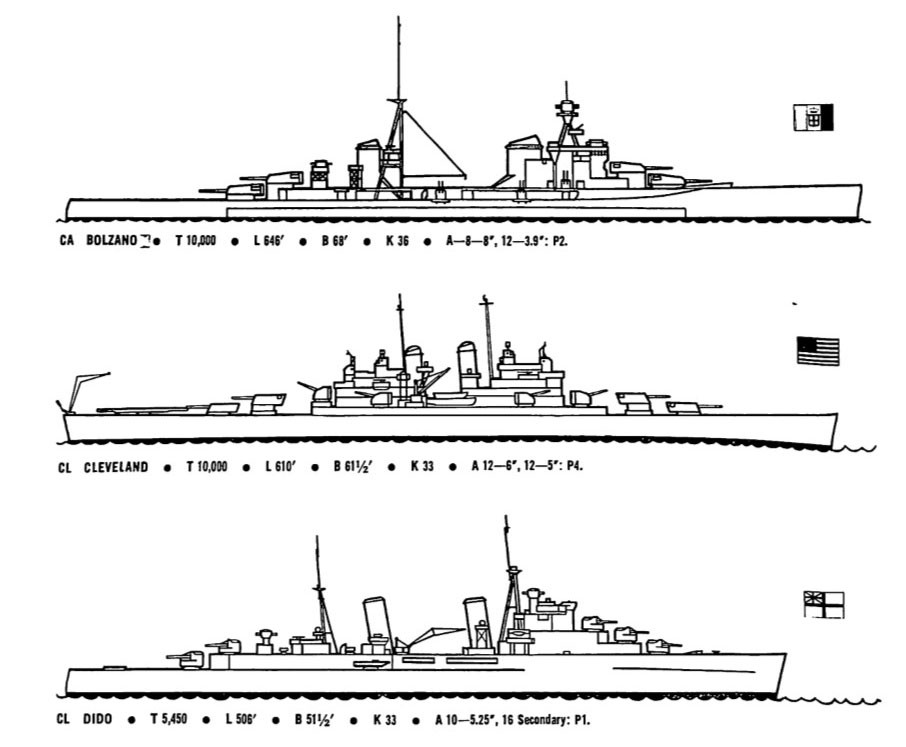
PRINCIPAL COMBATANT TYPES
HIMS BOLZANO A lightly armed and protected heavy cruiser. Like Littorio, a very fast "hit and run" ship with an impressive appearance. The arrangement of her masts and stacks is a noteworthy factor in identification of many Italian cruisers.
USS CLEVELAND A large light cruiser, well protected and with requisite speed and endurance for extended operation. Some sacrifice in main armament has been made in favor of heavier AA defense. Her appearance is characteristic of trends in recent U. S. cruiser design. Here again, as in Atago, the tendency towards concen- tration of superstructure becomes apparent.
HMS DIDO Alight light cruiser. Highly effect- tive as a screening unit. Relatively inexpensive, these ships can be built in numbers. Their mobility and endurance are excellent and their protection adequate for their size. The high rate of fire from her powerful battery of 10 5.25" dual purpose guns makes her a dangerous opponent for any type short of a battleship. Note that her three forward turrets are superimposed.
16
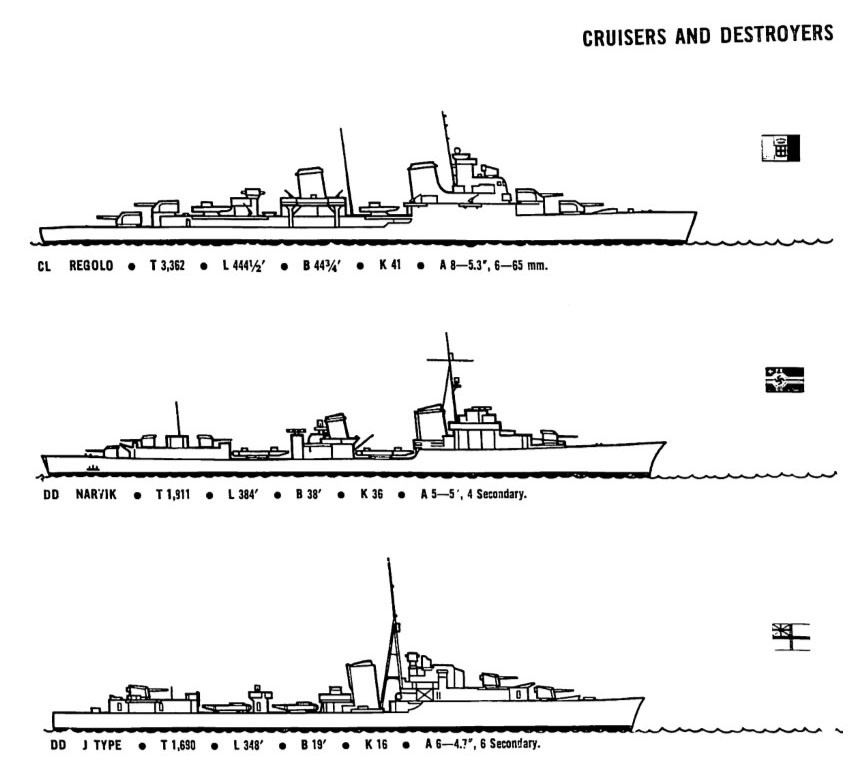
HMS REGOLO These ships mark the transition from cruisers to destroyers and are the smallest of modern cruisers. They are highly mobile, with limited endurance and with protection re- stricted to compartmentation except for a light armored deck and splinter protection. They carry 5.3" dual purpose guns and are essen- tially designed as screening units.
NARVIK class destroyer (German) A further step in the transition from crusiser to destroyer, these ships represent an attempt to endow a destroyer with a cruiser's fire power. Though fast, the Narviks lack the stability, protection and endur- ance of larger types and reflect the needs of a Navy desperately short of cruisers.
HMS JAVELIN A heavily gunned fleet destroyer of moderate size and cost. Tough customers, the low silhouette of these ships constitutes a distinct tactical asset. These are the ships that have borne the brunt of convoy and patrol work for the British Navy in the present war.
17
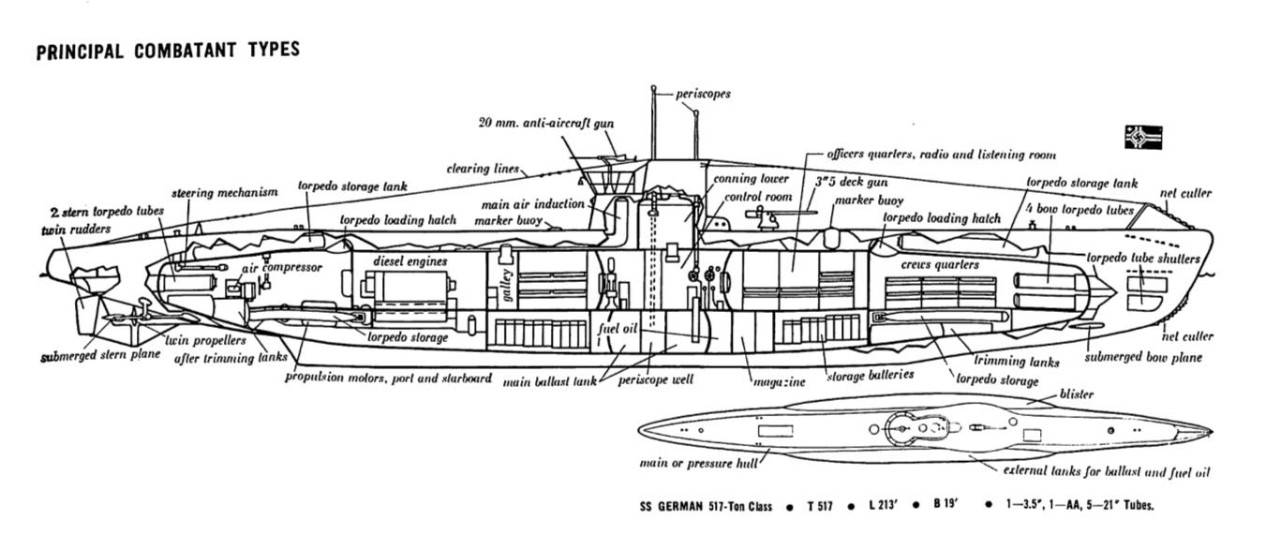
Identification of submarines, either by nationality or type, constitutes a difficult problem. Their low freeboard and simple superstructures give ships of this type a similarity of appearance that has resulted in many errors. At sea it is hard to gauge their dimensions and only careful study of the distin- guishing characteristics of these craft will enable the observer to differentiate them. Operating independently, these craft raid convoys singly or in packs, pick off lone vessels or execute long-range strategic reconnaissance missions. Attached to a fleet or task force they may act as scouts in support of their own surface ships. While the torpedo is the submarine's principal weapon, some specialized types are highly effective mine layers. Reference to O. N. I. 220-A, O. N. I. 220-B and O. N. I.220-M will provide further information on the appearance of submarines of the belligerent powers.
The 517-ton class of German U-boat is a typical medium size, sea going submarine. Tactically very efficient, the unusually stout pressure hulls of these ships increase resistance to attack. Submarines are best. identified through observation of the shape of conning towers and gun locations. Note the high, tank-like shape of the U-boats' conning towers as contrasted with the relatively low, narrow conning towers of other types. Gun locations may be not only an indication of nationality, but of size and type. For example, the presence of an after-deck gun will usually distinguish the larger 740-ton U-boat from the 517 tonner shown above.
18
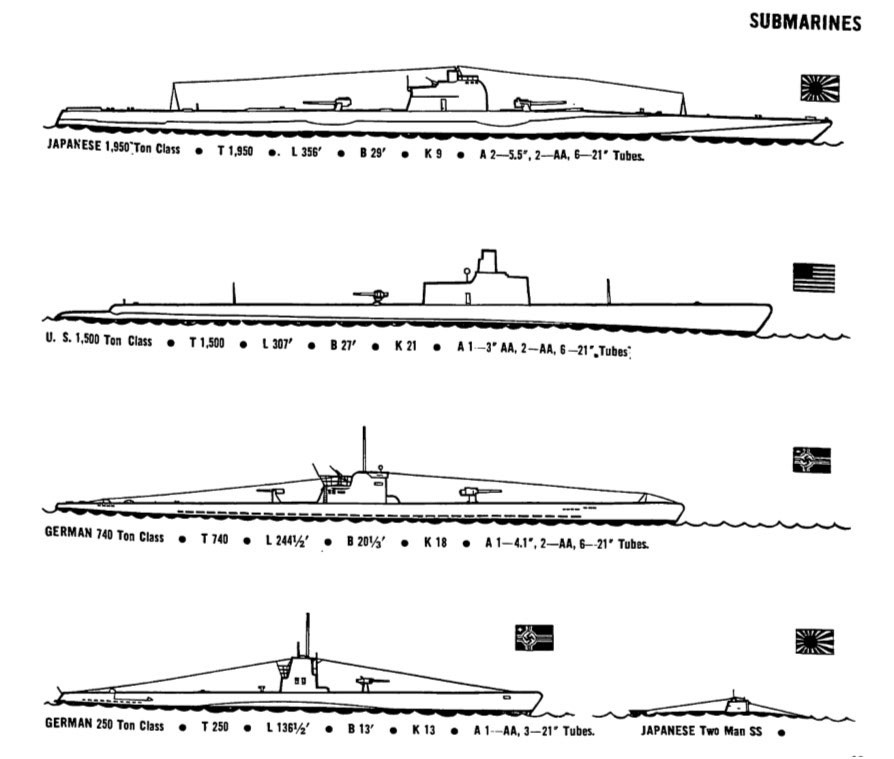
The submarine's capacity to render herself invisible through submergence and high average endurance enable these ships to operate in waters inaccessible to surface types. The smaller the submarine the greater is its tactical efficiency, and despite improved antisubmarine methods these ships have accounted for more tonnage in the present war than any other type.
2,000-ton Submarine JAP Characteristic of the larger ships of this type, they are capable of crossing the widest ocean and operating inde- pendently far from a base. Capacity to remain at sea is reflected in their size, and their deck guns make these ships dangerous surface opponents for armed merchantmen and patrol craft.
USS GATO A long-range oceangoing submarine of the last type. Improved design and a reduction in gun armament have resulted in smaller dimensions.
740-ton submarine GERMAN An enlarged version of the 517-ton U-boat. A 4.1" deck gun and slightly more speed and endurance are reflected in increased displacement.
250-ton submarine GERMAN A coast defense edition of the 517-ton U-boat. The midget submarine must usually he carried to a scene of action by a large "mother" submarine or other vessel since endurance in this type is limited.
19
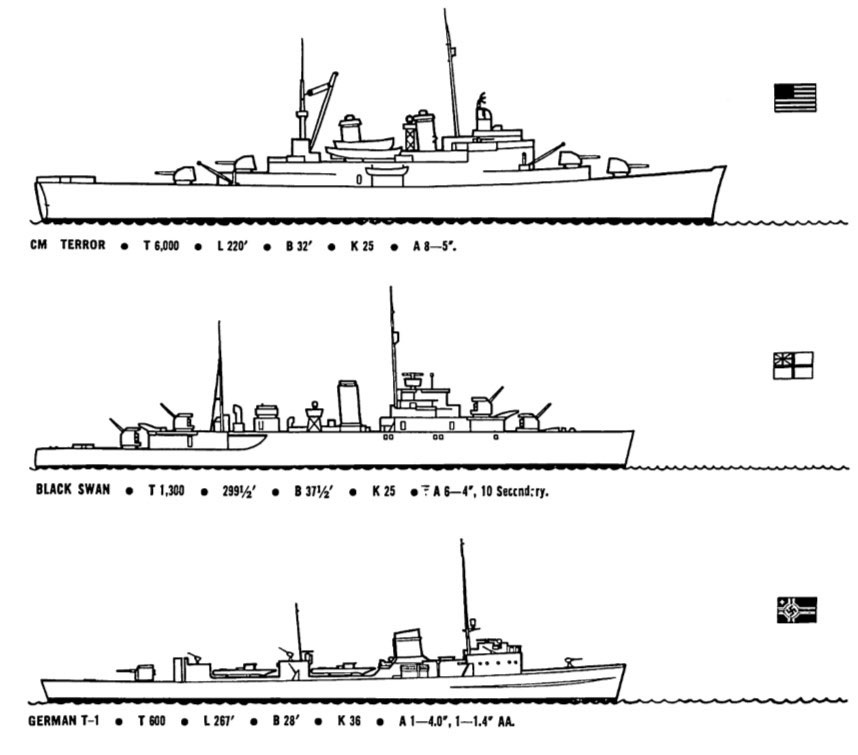
MINOR COMBATANT TYPES
Minor combatant types comprise fighting ships of lesser individual importance which supplement or support the types shown in the foregoing pages. These ships seldom operate tactically in fleet or fast task force missions. They perform very important work with the weapons they carry and should be distinguished from auxiliaries which are primarily service or transport units.
USS TERROR A large-capacity mine layer ca- pable of laying a mine field in short order. All other attributes have been subordinated in her design.
HMS BLACK SWAN A British "sloop," the equivalent of the gunboats used in our service. She is characteristic of ships of her type. Small and cheap to build, these vessels are used as ocean convoy escorts, AA ships, submarine hunters, supporting units in combined opera- tions, and for routine patrolling. They can also be pressed into service as mine layers and mine sweepers.
TORPEDO BOAT. A miniature destroyer which can perform a number of destroyer's tasks where endurance and fire power are not essential. They are powerful torpedo armament, and high speed and low silhouettes make them dangerous opponents under low visibility conditions.
20
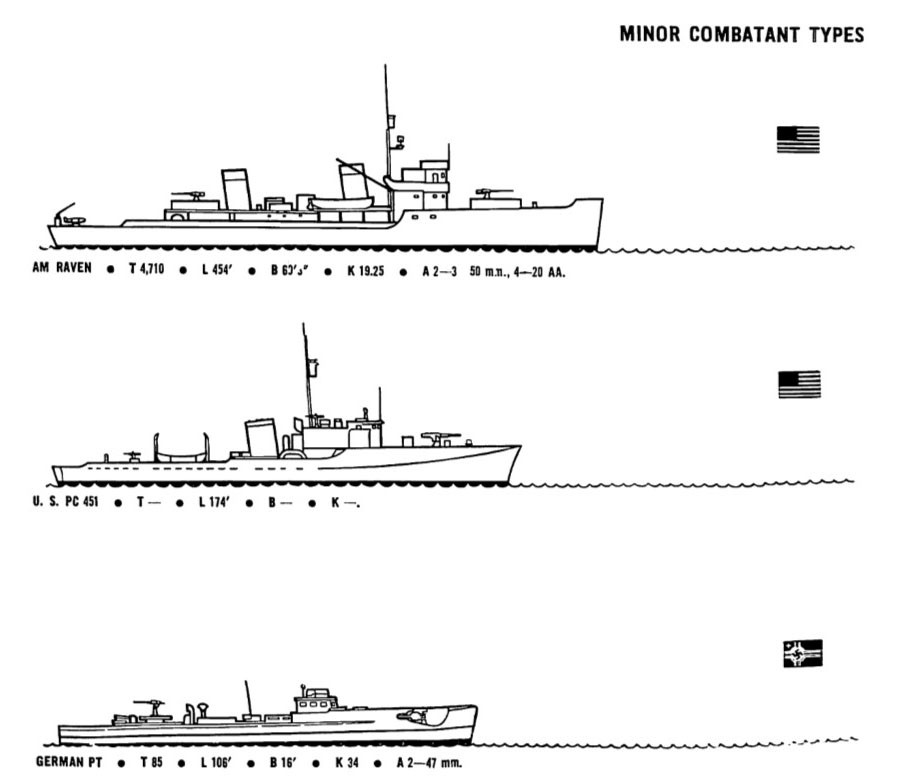
USS RAVEN A typical mine sweeper. Espe- cially designed for sweeping; though somewhat smaller and weaker than a gunboat, these ships can perform most of the tasks of the latter types. This class of U. S. minesweeper carries both magnetic and dragging gear and is sufficiently seaworthy and well-armed to enable them to function as useful little fighting ships in addition to the performance of their primary function.
P. C. BOAT (U. S.) These submarine chasers are specifically designed to run down and destroy submarines by depth-charge attack, gunfire, or ramming. Small, cheap, and expendable, they are very useful for coastal convoy and patrol work, and relieve larger craft of many major tasks.
PT BOAT (Germany) The embodiment of hi t-and- run tactics. These little vessels are designed for speeds of over thirty knots. Lightly built and extremely mobile, they are surprise attack weapons, relying entirely on speed and maneu- verability for their protection. The torpedo constitutes their sole means of offensive action and night affords them cover for most effective operation. It was the U. S. equivalent of this type that operated so effectively in the Philip- pines before the fall of Bataan.
21
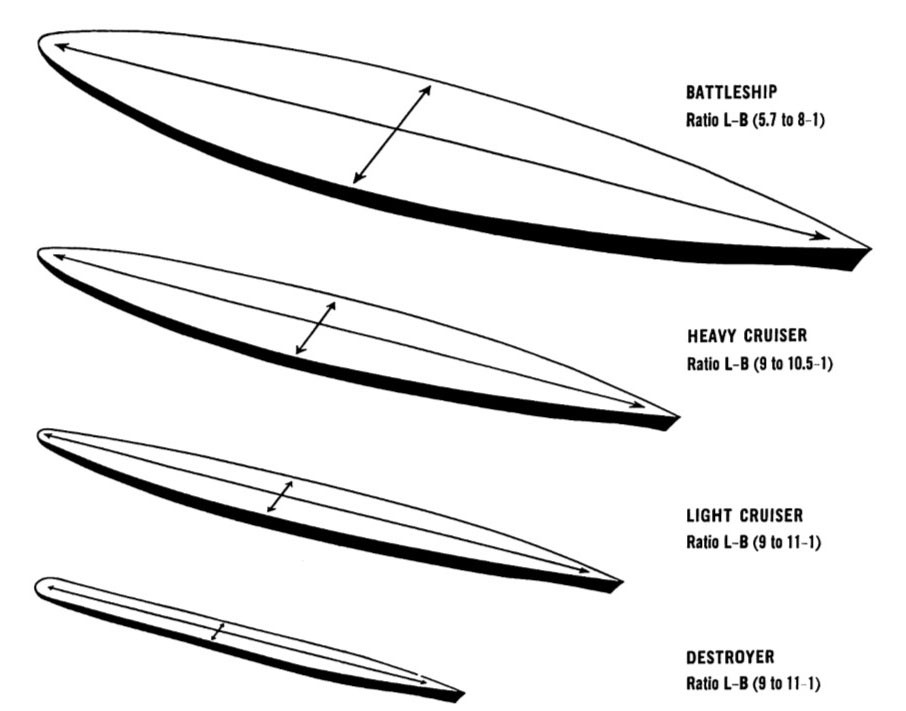
HULL PROPORTIONS
SHIP SHAPES.
A ship's function is reflected in the design of her hull. The long-range, heavily protected battleship has the beam necessary to make her a stable gun platform, to contain within her hull the crew, equipment, and supplies necessary for long voyages and for maintenance of her complex organism, and to give her the longitudinal compartmentation necessary for protection from shell fire and torpedo attack. Battleships are, therefore, the "beamiest" of fighting ships, while destroyers and torpedo boats appear, when seen from above or from fore and aft the most slender, since they are reduced to the barest essentials for the sake of maximum speed and maneuverability. Heavy cruisers, since they must combine speed with cruising range and limited protection, have hulls with a ratio of length to beam (L/B) about half way between those of battleships and destroyers, while light cruisers decrease in beam as they grow smaller until their hull proportions are indistinguishable from those of destroyers. Note, however, that the typical cruiser's hull is more tapering and less flat-sided than the destroyer's, while presence of a continuous hull curve from stem to stern is a characteristic of battleships. There are some important variations to the hull types illustrated, notably in U. S. cruisers with square "transom" sterns and in a few Japanese cruisers whose hull shapes closely resemble destroyers'.
These are, of course, generalizations, and will he found to vary considerably, but L/B ratio remains the most useful means of determining type.
22
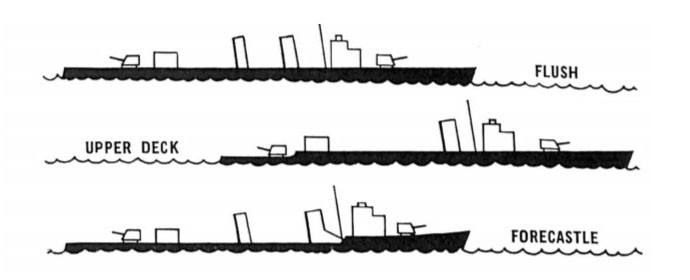
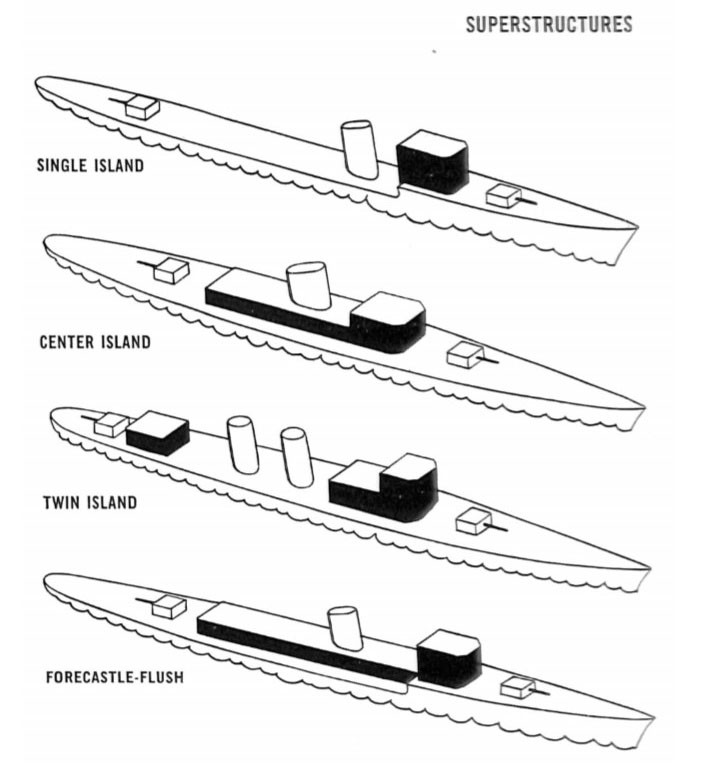
DECK LINES AND SUPERSTRUCTURE TYPES
Breaks in deck lines will often differentiate one ship from another. These are not usually difficult to observe in more modern ships, but may not be clearly distinguishable in older battleships which carry their secondary batteries along their sides rat her than on deck .
A ship's superstructure may fall into one of three classifications. When a structure occurs forward of the ship’s center she is known as a "single island " type. If two unconnected deck structures appear the ship is a "twin island " type, while if the ship h as a continuous structure amidships she is of the “center island” type. Further classifications result from a combination of deck lines and superstructures, as shown on this page. It should be remem- bered that it is often difficult to classify positively superstructure types which appear in many larger ships because of the presence of boats and other gear which clutter the ‘midship sections of t h ese ships and often obscure their superstructures. Narrow "wells” or spaces between superstructure elements are a l so difficult to observe from a ny position other than full broadside. (In this · connection see Tirpitz, p . 10.) It is therefore well to avoid reporting a ship as having a n y special type of superstructure unless one has had an opportunity for thorough observation from a broad side position.
23
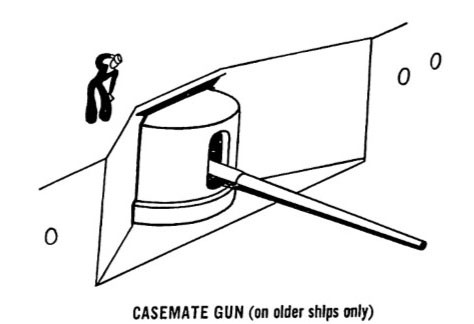

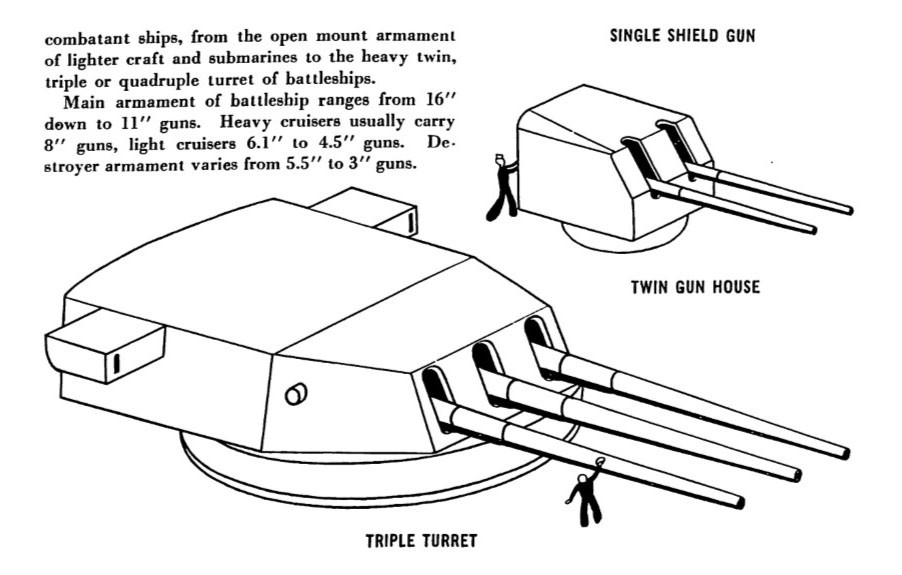
ARMAMENT
Gun houses, like turrets, are wholly enclosed. Turrets occur only on the centerlines of larger ships. They are of greater size and their proportions are lower than those of gun houses.
A great variety of main armament dispositions occurs among the world's fighting ships. These are usually clearly discernible from the air and their observation constitutes one of the most useful determinants in identification. Since secondary armament is often difficult to see it is advisable to base identification only on main armament appear- ing along the centerline of the ship observed.
SHIPS' GUNS AND THEIR MOUNTS
With the exception of the casemate gun (generally a secondary gun on older type ships) the types here illustrated may form the main armament of all combatant ships, from the open mount armament of lighter craft and submarines to the heavy twin, triple or quadruple turret of battleships.
Main armament of battleship ranges from 16" down to 11" guns. Heavy cruisers usually carry 8" guns, light cruisers 6.1" to 4.5" guns. De· stroyer armament varies from 5.5" to 3"guns.
24
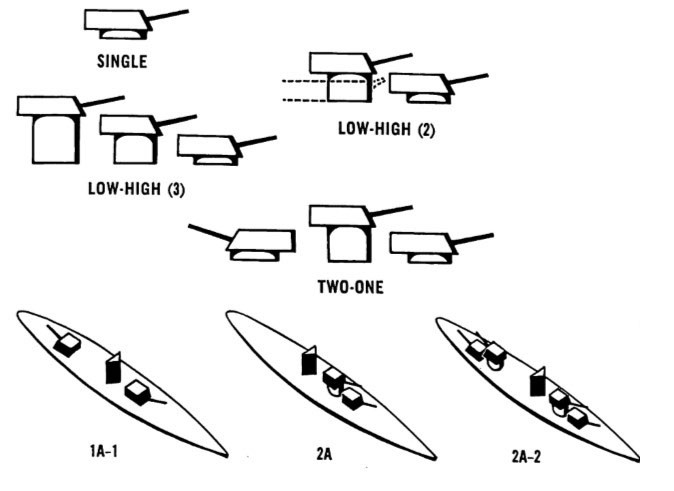
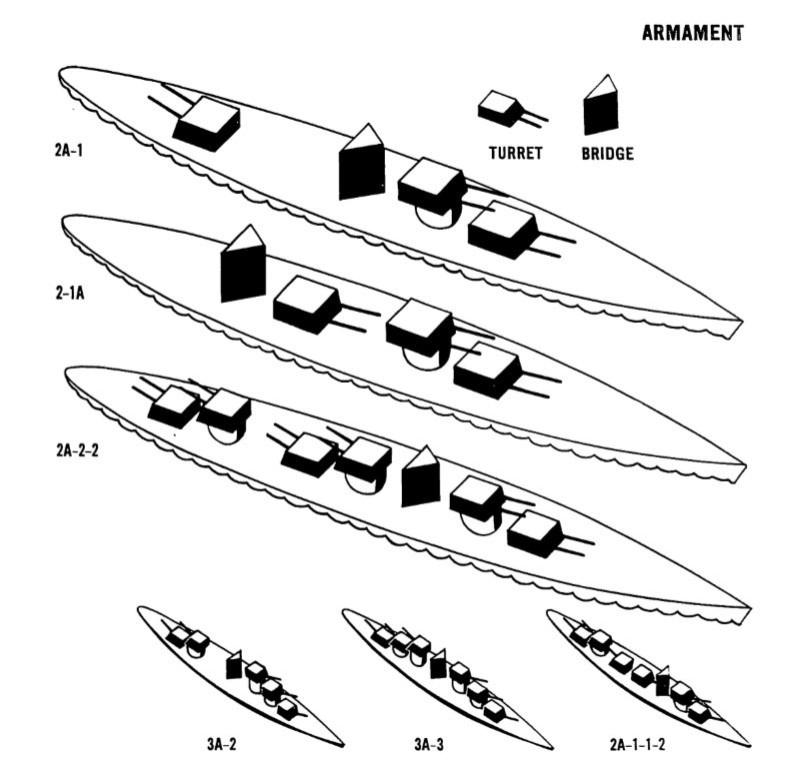
MAIN BATTERY DISPOSITION
Some variants of main battery dispositions are shown, together with a formula in which armament is expressed in terms of the descriptive classifications that appears on this page. Location of bridge structures is expressed by the letter A.
Reference to ONI 41-42 "Japanese Naval Vessels" will show that the various classes of Japanese battleships may be differenti- ated by their main armament alone. While this is an extreme case, it will be found that disposition of main armament is an extremely useful clue to identification.
25
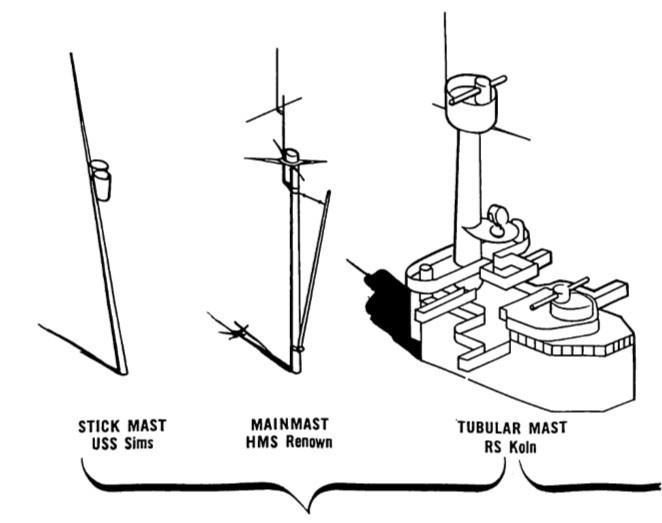
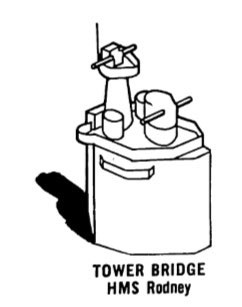
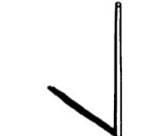
MASTS
Mast cannot always be assigned to one or another of the several types. Some are "border-line" cases, falling between two types, others are unique structures which belong in none of the standard classifications. Generally speaking, however, masts ma y be classified under one of the types which appear on these pages. It should be remembered that, of all elements of a ships structure, masts are most subject to alteration and addition. An example of this may be seen in older Japanese battleships, which began with tripod or quadrupod masts which have by now become so cluttered with galleries and flying bridges that the basic supporting structure has become invisible. These masts now fall into the category of pagodas or towers, but in t heir transitional phases it was impossible to assign them to any definite classification. Masts must, therefore, be observed carefully but in many instances should not be used as the basis for positive identification of a given ship.
For identification purposes, masts must often be considered in relation to bridge structures. Here again it is often unwise to assign a combination of mast and bridge to a definite classification where doubt exists in the observer's mind. Bridge forms may vary from low, box like structures to high towers. Typical tower bridges appear in Rodney and Nelson, and in our own New Mexico, and may be distinguished from tower or pagoda masts by the fact t h at the bridge structure rises vertically from the main deck , without a secondary structure a t the base Certain types of mast-bridge assem- blies are characteristic of various na- tionaliIies. The pylon-high bridge combination is typically Japanese, while the bridge-tower combination is common in large German ships. Some of the more common types of mast-bridge assemblies also appear on these pages.
POLE MAST
The pole or stick is the simplest and earliest of mast types. It has evolved in some cases into the tubular masts that appear in some ships of a number of nations, notably the German.
26
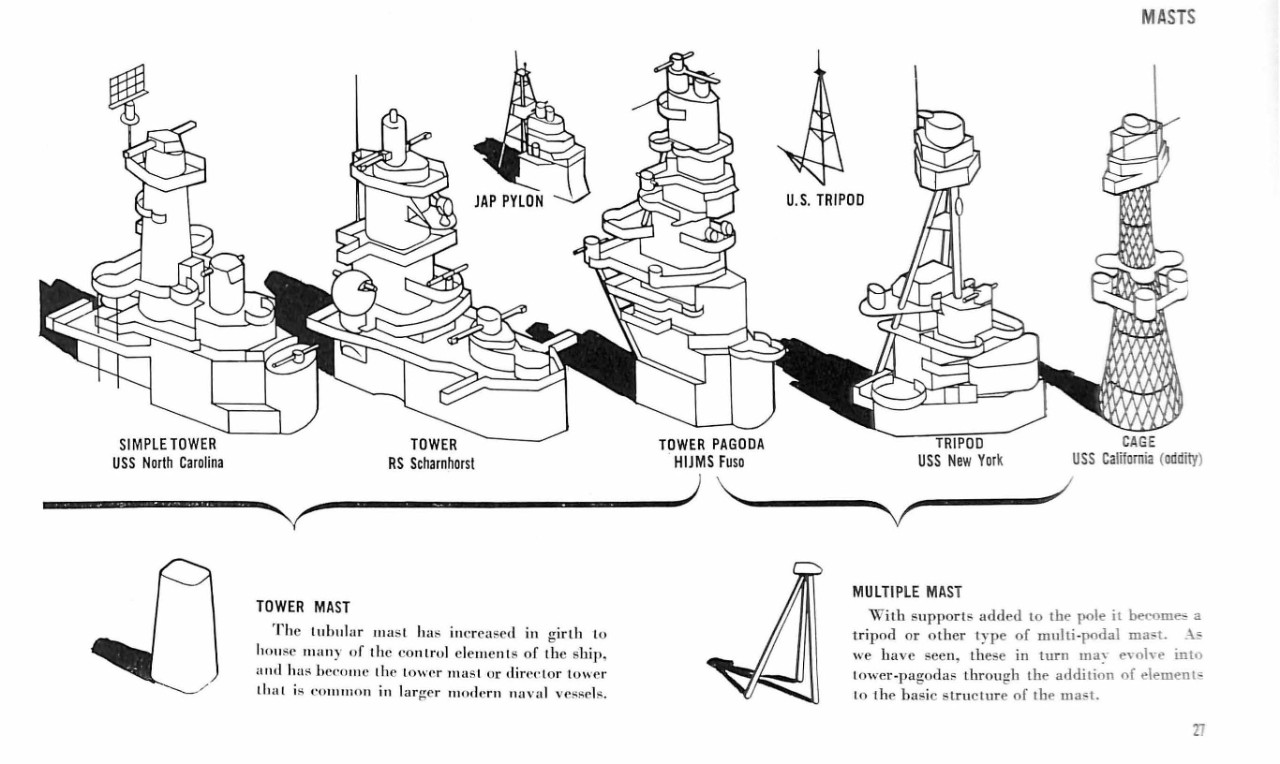
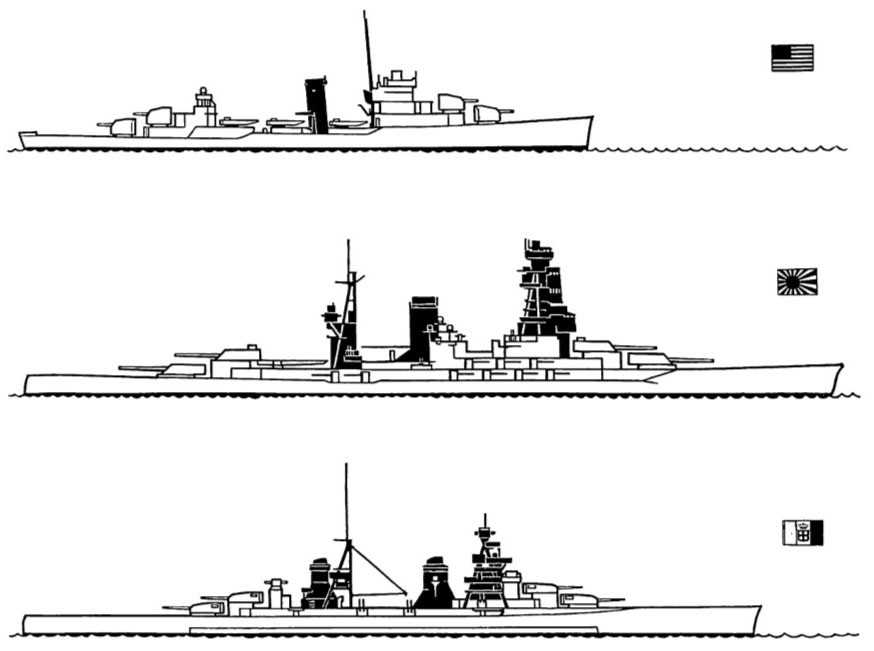
MAST-STACK SEQUENCE
Shape, number and relative size of stacks and their position in relation to masts and superstructures are important factors in warship identification. The form of a stack will often reveal a ship's nationality, while the number and comparative height and thickness of her stacks may serve to distinguish her from others of her type. In some instances sequence of masts and stacks convenience in reporting, this sequence may be expressed in a descriptive formula. Reading from bow to stern and using the number 1 to note the presence of a mast, and the letter F to represent a stack (or funnel) the mast-stack sequence of the DD. USS. Davis may be described as 1 - F.
The Mutsu has a 1-F-l sequence--While the Gorizia has a l-F-1-F arrangement. There is an infinite range of variation in the shapes, positions and sizes of stacks. Along with her masts, stacks constitute elements that create in a ship the peculiar national look that, once recognized, is unmistakable. The squat, cowled, Teutonic stacks of the German heavy units are an excellent example, and are very different in appearance and character from the low, heavy funnels of British battleships (see ONI 203). In Richelieu and Jean Bart French naval designers have created a new type in which mainmast and stack form a single structure. Since this is a feature peculiar to these ships alone, in them we see an example of identification of a class through themedium of stack design alone.
28
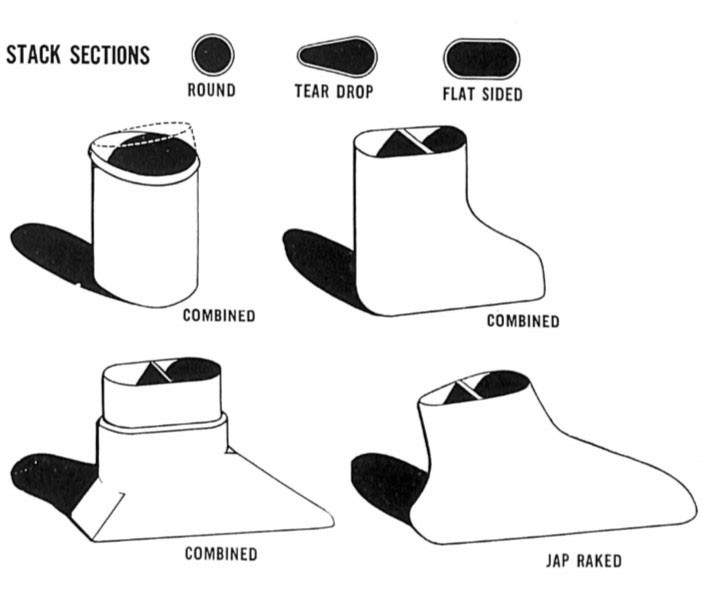
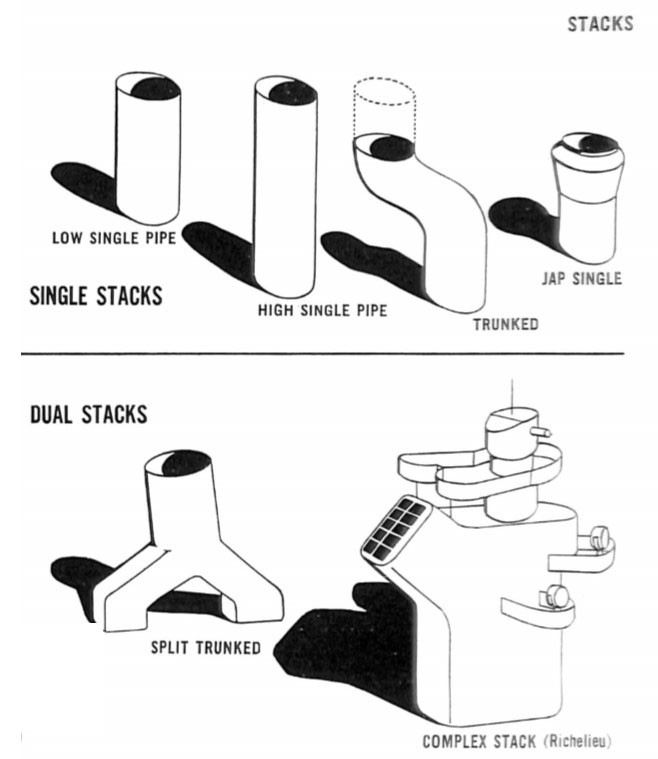
The stack most commonly observed is the single-pipe type. Stacks of this sort may be high or low raked (slanting) or straight, and cowlings or "clinker screens" may or may not appear. These peculiarities should be observed and reported . Multi -pipe stack s fall in to a number of ty pes. Some of these are peculiar to individual navies and are, therefore, useful factors in national identification. The more common stack variants are illustrated on this page.
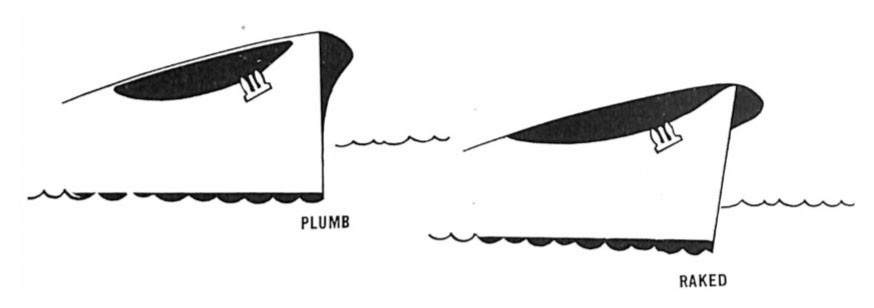
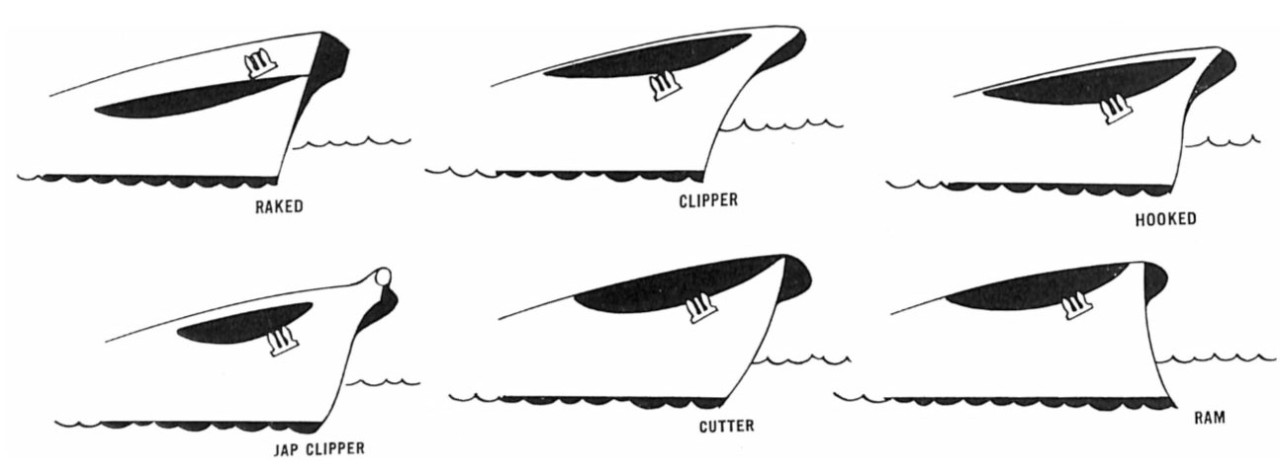
BOWS
The bow and s t em types that occur in fighting ships appear on these pages. These types are often difficult t o observe, and while the terms applied to them should be familiar to everyone who goes to sea, it is better not to attempt definite assignment of a bow or stern observed (to a definite type), if doubt exists. In such instances it may be found advisable to note only whether a bow or stern projects beyond the water line, forms a vertical line from water to deck or slopes back from the water line to the deck.
30
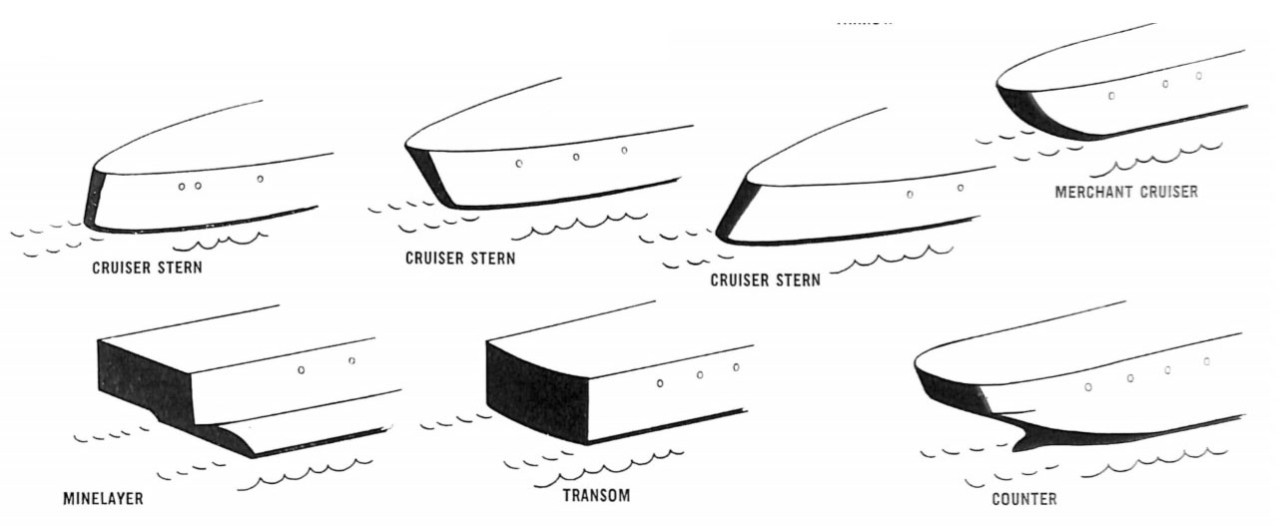
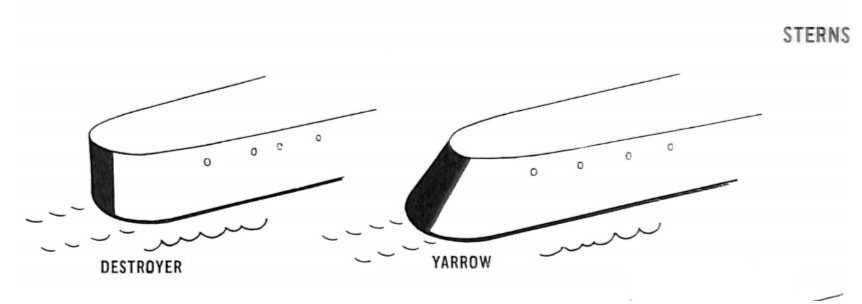
Most large warships are now designed with raking or clipper bows and cruiser sterns, although the transom sterns of U. S. and French cruisers are nolabe exception s, as are t he characteristic "hooked " bows of Japanese warships. Ram bows are survivals of an older school of naval design and invariaby indicate ships built at least twenty years' ago. Larger and newer U. S. ships are usually designed with characteristic blunted clipper bows, often difficult to distinguish from t he raked type common in lighter units.
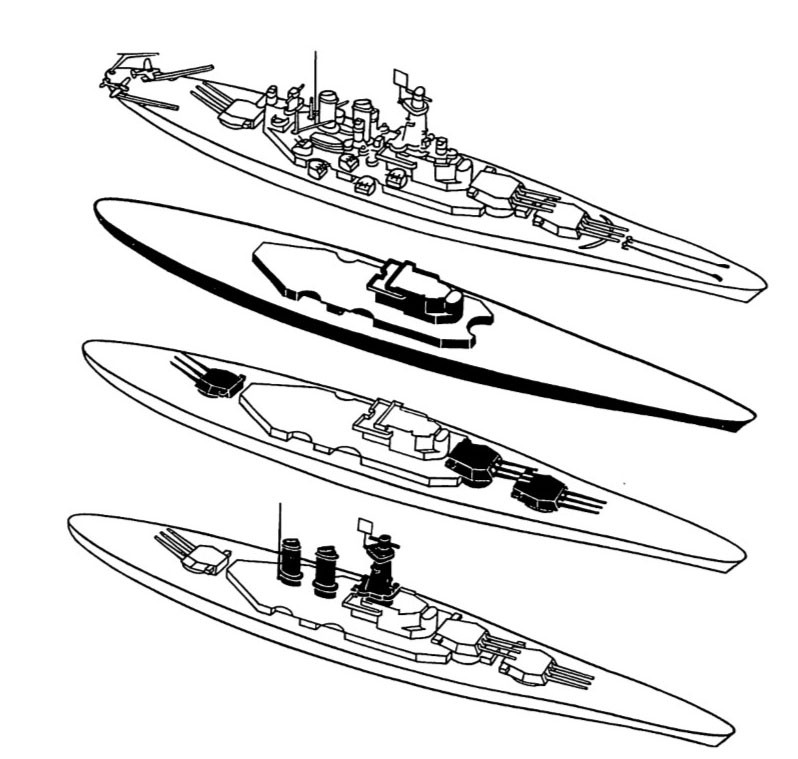
IDENTIFICATION OF A FIGHTING SHIP
Here is a ship. Q. What are the proportions of her hull? A. Seen from above she has a broad hull, with continuous curve from stem to stern. Probably a battleship. Q. What type of hull in profile? A. Aflush hull. Q. What type of superstruc ture? A. A single island superstructure. Q. What is her main battery disposition? A. Superimposed turrets forward, one turret aft, or 2-A-1. Q. How many stacks has she and of what type? A. Two high, straight, singlepipe stacks. Q. What is her mast-stack arrangement? A. Mast, stack, stack mast, or 1-F-F-I. Q. What type of masts has she? A. A high, simple tower foremast and a stick mainmast. Q. What type of bow and stern? |
A. Her bow is of the clipper type, her stern of the cruiser type. Besides these elements you will notice the large and rela· tively low turrets along this ship's centerline, which will confirm your conclusion as to her type. You will note the long run of deck forward of her bridge, with marked sheer line curving up toward the bow. The prominent housings of her secondary batteries are also notable, as are the high, cylindrical range finders on her bridge and after deck house. If your know your ships, a glance will tell you that she is the U. S. S North Carolina. However, since most of us have not learned to identify all the world's warships at a glance, remember that these are the elements that must be observed and noticed in the process of identifying a ship. Learn to associate their variants with the types and individual ships of our own Navy and the navies of our enemies. |
U.S.GOVERNMENT PRINTING OFFICE: 1943
32
